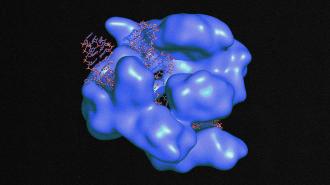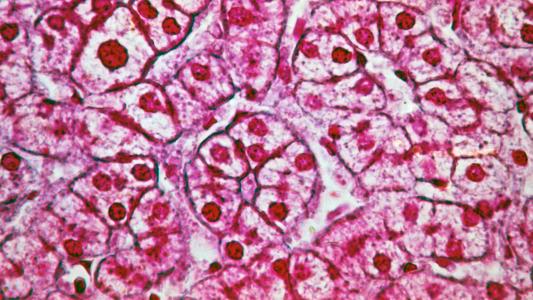This article is an installment of Future Explored, a weekly guide to world-changing technology. You can get stories like this one straight to your inbox every Thursday morning by subscribing here.
Being diagnosed with AIDS used to be a death sentence — in the US, more than half of those diagnosed with the disease between 1981 and 1992 died within 2 years.
Today, though, the life expectancy of someone in the US who is infected with HIV — the virus that causes AIDS — is about the same as the rest of the population.
This is largely thanks to antiretroviral therapy (ART), a treatment regimen consisting of daily medications that can decrease the level of HIV in a person’s blood to the point it’s no longer detectable — or even transmittable.
ART doesn’t cure HIV, though — the virus is still hiding out in the immune system’s helper T cells in a dormant, or “latent,” state. If a person stops taking their ART meds, the virus will become active again and start proliferating in the body.
Adhering to daily ART can be difficult for some people, and access to the treatment isn’t yet universal, so we’re still seeing more than 60,000 HIV-related deaths every year, with the highest rates being in sub-Saharan Africa.
Over the past 15 years, though, a handful of people have been able to reach undetectable HIV levels even while off ART, essentially meaning they’ve been cured of HIV — and new, universal cures are just on the horizon.
Stem cell transplants
The cure: The first person ever cured of HIV was Timothy Ray Brown, aka the “Berlin Patient,” who was attending university in Berlin in 1995 when he was diagnosed with HIV and began ART.
In 2006, Brown was diagnosed with acute myeloid leukemia (AML), a type of cancer that starts in the bone marrow and blood. To treat it, he underwent chemotherapy and then received a transplant of stem cells from bone marrow in 2007.
Because Brown was lucky enough to have more than 250 matches in the bone marrow donor database, his doctors decided to screen the donors to find one with a genetic mutation, called “CCR5 Delta 32,” that makes people virtually immune to HIV infection.
Three months after the transplant — and three months after he stopped taking ART — doctors could no longer find any HIV in Brown’s blood.
His case was presented as the first example of someone cured of HIV at the Conference on Retroviruses and Opportunistic Infections in 2008, and his HIV remained undetectable until his death from cancer in 2020.
Since then, at least two other people — the “London patient” and the “Düsseldorf patient” — have been cured of HIV following bone marrow transplants to treat their cancers.
Bone marrow transplants are expensive and risky, but a better alternative is already emerging.
The drawbacks: Many people in need of bone marrow transplants are unable to find any match in donor databases, and the CCR5 Delta 32 mutation is relatively rare, meaning finding a match who also has the variant could be impossible for many people with HIV.
Even if a match with the mutation is available, bone marrow transplants are incredibly expensive and risky — doctors first have to essentially wipe out a recipient’s immune system prior to the transplant, and Brown nearly died after the procedure.
That means a transplant is probably never going to be a worthwhile option for people with HIV who don’t need one to address some other health issue, such as cancer, especially when highly effective ART is available.
Looking ahead: In 2017, doctors used stem cells from the donated umbilical cord blood of a baby with the CCR5 Delta 32 mutation to treat a woman’s leukemia and cure her HIV.
While this type of transplant is still risky, it’s not as risky as a bone marrow transplant. Umbilical cord blood is also more available than donated bone marrow and doesn’t have to match a recipient as closely.
That could make it a better option for others battling both HIV and other diseases that could benefit from a stem cell transplant.
CRISPR
The cure: Several in-development cures for HIV are built around the gene-editing technology CRISPR, and one of the most promising is being developed by California-based biotech company Excision BioTherapeutics.
The treatment, EBT-101, is delivered as a single IV infusion of a harmless virus. Inside the virus is a CRISPR system programmed to find HIV hiding dormant in helper T cells, travel to three sites in the virus’ genome, and cut out big chunks of its DNA, preventing it from ever being able to reemerge and replicate itself.
In August 2023, Excision announced that a version of EBT-101 designed to treat SIV — a virus closely related to HIV that infects non-human primates — proved safe in a monkey study, and it also found evidence that the CRISPR system reached and edited target DNA in “all significant viral reservoirs.”
“Our study supports safety and demonstrates evidence of in vivo SIV editing of a CRISPR gene-editing technology aimed at the permanent inactivation of virus in a broad range of tissues in a large, preclinical animal model, using a one-time injection of the treatment,” said senior investigator Kamel Khalili.
Any infected cells missed by CRISPR could begin reproducing HIV if a person stops taking ART.
The drawbacks: While the results of the monkey study were promising, they only show that the CRISPR treatment appears safe and capable of reaching the right cells.
All 12 monkeys involved in it remained on ART from the beginning of the study until they were sacrificed so that the researchers could study their tissues, which means it’s not clear if they were actually cured of HIV by this treatment.
A big challenge with any CRISPR therapy is getting the system to act on enough cells to be effective. This could prove to be an insurmountable hurdle when trying to treat HIV as any infected cells have the potential to begin reproducing the virus if a person stops taking ART.
Looking ahead: If EBT-101 can cure HIV, it would be a way easier approach than a stem cell transplant, and Excision has already launched a human clinical trial testing the therapy in up to 9 people taking ART to suppress their HIV.
The primary goal of the trial is to test the safety and tolerability of EBT-101, but eligible participants may go off their ART meds during the trial to see if the treatment prevents their HIV from rebounding.
That trial is expected to wrap up in March 2025, but the researchers plan to follow up with participants for up to 15 years to assess the long-term effect of the CRISPR-based treatment.
Cancer drug
The cure: Venetoclax is the latest lead in the hunt for an HIV cure. This drug is already FDA approved to treat several cancers by binding to BCL-2, a protein that is overexpressed in cancer cells. That interferes with the cells’ ability to survive and resist treatments.
BCL-2 also appears to help infected T cells hosting dormant HIV survive and avoid the immune system. This prompted researchers at WEHI — the Australia-based medical research institute that co-developed venetoclax — to wonder if the drug could also treat HIV.
They teamed up with researchers at the Doherty Institute to test the drug on T cells donated by people taking ART for their HIV. This led to the discovery that the drug could reduce the amount of HIV DNA in the cells.
Next, they treated mouse models of HIV with ART until the virus was suppressed. While continuing ART, they administered venetoclax to some of the animals five times a week for six weeks. The rest of the animals received just ART.
All treatments were stopped at six weeks, and in the control mice that had received only ART, the HIV rebounded one week later. It took two weeks for the HIV to rebound in the mice that received both ART and venetoclax, though.
“One drug may not be enough to completely eliminate HIV.”
Philip Arandjelovic
The drawbacks: Delayed rebound is still rebound — none of the mice were actually cured of HIV.
However, when the researchers treated HIV mouse models with venetoclax and an in-development cancer drug — S63845 — for three weeks, it took up to four weeks for the HIV to rebound. (The cancer drug alone didn’t perform as well.)
This suggests that venetoclax could be part of a cure for HIV.
“It has long been understood that one drug may not be enough to completely eliminate HIV,” said co-first author Philip Arandjelovic. “This finding has supported that theory, while uncovering venetoclax’s powerful potential as a weapon against HIV.”
Looking ahead: A phase 1/2B clinical trial of venetoclax to treat HIV is set to kick off near the end of 2023 in Denmark before expanding to Australia in 2024.
In addition to helping determine whether it’s safe for people taking ART to also take venetoclax, a goal of the trial is to help researchers learn more about what the drug does in the bodies of people with HIV.
This information could help identify meds that could be paired with venetoclax to ensure HIV never rebounds after a person stops taking ART.
At least two “elite controllers” have functionally cured themselves of HIV without any treatment.
The big picture
In addition to these in-development cures for HIV, we’re also seeing the creation of treatments that make it easier for people to live with the virus, including ART that can be delivered as a monthly or bi-monthly injection, rather than daily pills.
New ways to prevent people from contracting HIV at all are also emerging, including vaginal rings and bi-monthly injections of drugs that prevent HIV infection.
Because these treatments and preventatives only have to be administered once every month or two, they are easier to adhere to than daily alternatives, as well as easier to deploy in places where the HIV crisis is most severe, such as sub-Saharan Africa.
Several promising HIV vaccines, including ones based on mRNA technology, are now in clinical trials, too. Those shots could also be a huge boon in the areas suffering most from HIV infections.
Ultimately, though, we still need a cure for HIV to help people already living with the disease, and it’s possible nature has already developed it: at least two women (rare “elite controllers” whose immune system can naturally suppress the virus with treatment) have not only controlled the virus but functionally cured themselves of HIV.
Researchers are now studying those women, looking for connections that might explain how their bodies were able to get rid of the virus — and how that might be translated into a cure for others living with HIV.
We’d love to hear from you! If you have a comment about this article or if you have a tip for a future Freethink story, please email us at [email protected].






